Planting Season In Farm Fields and Garden Beds
May 8, 2020
By Kelly Visser, Iowa Food & Family Project
Farming and gardening have a lot in common. Both take hard work, spark ingenuity and inspire an intense appreciation for how food is grown and raised.
With each bird chirp, blooming tree and extra minute of daylight, Iowans are growing more eager to get their hands dirty this spring! Across the state, soybean and corn farmers are working tirelessly to plant an estimated 23.4 million acres of farmland. And with social distancing measures keeping many Iowans at home, novice and experienced gardeners are excited to spend their time planting produce and colorful flower beds.
To learn how planting row crops compares with planting backyard gardens, the Iowa Food & Family Project (Iowa FFP) connected with Mark Jackson, a soybean, corn and livestock farmer in Mahaska County.
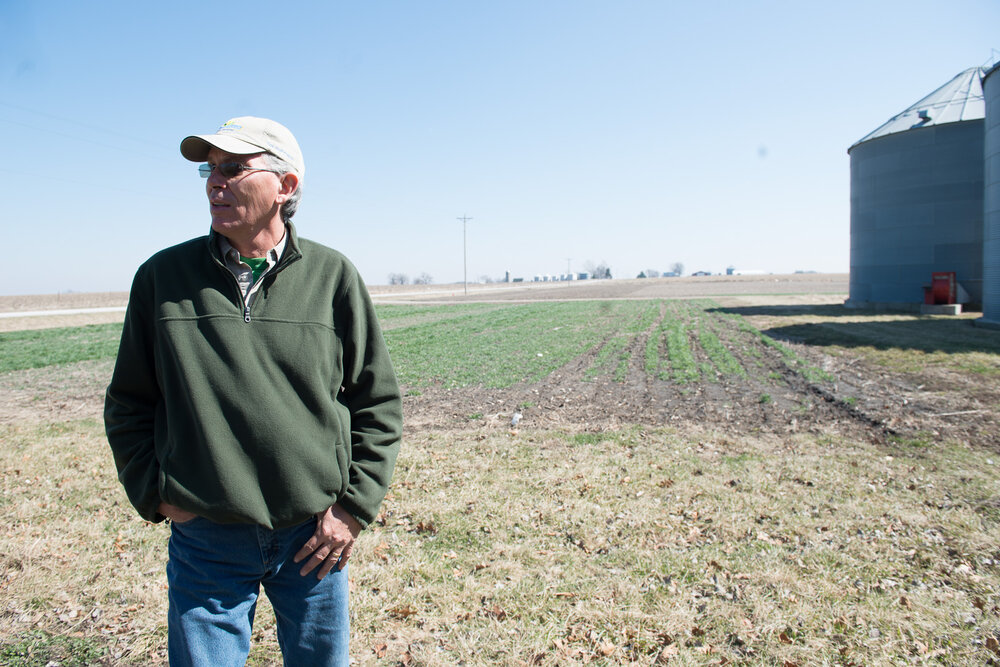
Iowa FFP: How do you decide what to plant? And how do you determine the ratio?
Mark: We use a corn and soybean rotation on our farm, which means corn acres this year will be soybean acres next year. We do this because the two crops complement each other.
Corn is a grass species that needs nitrogen in the soil and soybeans are a legume that fix nitrogen in the soil – they really work in harmony. Nitrogen is vital to plant growth, development and reproduction. We always say for every bushel of soybeans, we get a pound of nitrogen from Mother Nature. It’s part of the sustainability cycle on our farm because we don’t have the added cost of applying nitrogen.
Iowa FFP: Why is soil so important? How do you prepare the soil?
Mark: It is important to understand your soil pH, nutrients and organic matter. On our farm, we do soil sampling every four years. This means we take samples every 2.5 acres across a grid. We then work with agronomists to evaluate the results to see if we need to adjust pH or nutrients on that specific plot of land.
On a smaller scale, gardeners can sample their backyard soil like farmers do. There are a variety of test kits to learn what nutrients are in the soil, and then the experts at Earl May Nursery & Garden Center can give guidance on which soil amendments – like compost or fertilizers – to work into the soil. Or if your plant is showing a specific kind of disease, garden experts might be able to identify that your soil pH or nutrients are out of balance. Generally, a soil pH in the range of 6.0 to 7.0 is good for vegetables.
On our farm, we use no-till practices and cover crops to increase organic matter in the soil. No-till leaves residue (like corn stalks) from last year’s crop on the field, and cover crops (like cereal rye) help hold nutrients in the soil over winter. These practices ultimately help build soil structure, which helps water permeate through the soil and reduce erosion.
You can think of no-till and cover crop residue like mulch in your backyard garden.
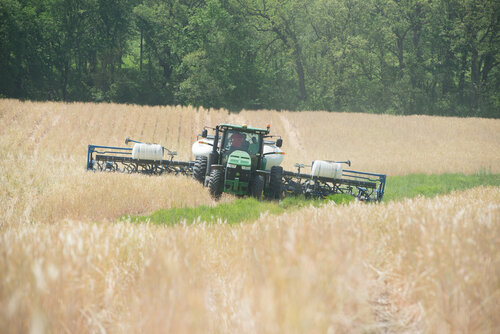
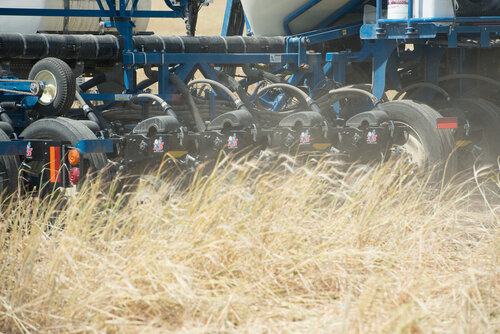
<
Iowa FFP: What goes into selecting corn and soybean seed varieties?
Mark: I look for a number of characteristics when selecting which seed varieties to purchase and plant, similar to how you might have a list of criteria when buying a new car.
Because we use cover crops and no-till practices, there is more bacteria in the soil, which means I look for seeds with high disease resistance. We don’t use any irrigation on our farm, so it’s important to also have a drought-resistant variety. We like to plant three to four varieties of seeds across our crop to spread out the risk because you never know how Mother Nature might impact a certain variety.
Years before a seed is on the market, companies use genetics and cross-pollination to develop new and improved varieties in test plots. They rank plant characteristics like plant health, drought resistance, yield, dry down and standability across a 1-5 scale. Farmers can purchase the variety that fits best with their agricultural needs.
Once we work with our seed dealer to find the varieties that fit our criteria, it’s time to buy. And like a car, after a few years there’s a new “model” on the market. As technology and genetics improve, it may be time to “upgrade” our go-to seed choices.
Iowa FFP: How do you decide when to start planting?
Mark: We use science as our front-runner, but historical trends and traditions are also important. Every year is a new year in agriculture, thanks to Mother Nature.
My grandfather used to say, “When the oak leaves are the size of a squirrel’s ear, it is time to plant corn.” At the time, he was doing the best with what he had to make the decision. Now, we have the support of public universities, associations and private seed companies to help us decide when to plant.
I keep a digital thermometer in my back pocket, so I can test soil temperature leading up to planting.
Corn germinates at 50 degrees F. We will often plant at 45 degrees F, as long as the forecast is warming, and it takes about two weeks for corn to emerge from the ground. Corn’s growing point is at the roots, so if a frost did hit after it has emerged from the soil, it has some protection.
Soybeans germinate closer to 60 degrees F. They are hardier than we might think, but their growing point is above ground, so a frost can be devastating if they have emerged from the ground.
This year, we didn’t start planting until the third week of April, and typically we like to start the second week in April. The timing usually varies across the state.
Knowing the plant species is important in decision making, and that’s for gardeners, too. The experts at Earl May can help you know which crops are OK to plant in colder soil temperatures – like peas, onion bulbs or potatoes – and which you should wait until later in the spring. And as a gardener, you have the luxury of covering your plants with a sheet or milk jug if an untimely frost is predicted.
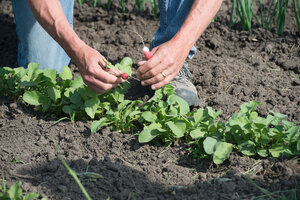
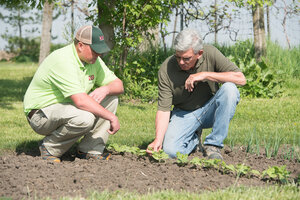
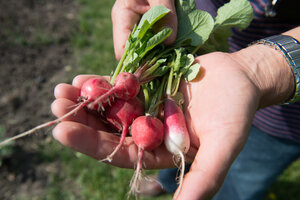
Iowa FFP: What kind of equipment do you use?
Mark: While gardeners use their hands, shovels and trowels, farmers need advanced planting equipment to work on a larger scale. We rely on precision technology to guide the path of our planter, vary the application of fertilizers and nutrients and adapt seed depth and rate. For example, this technology allows us to place fertilizer precisely where the plant needs it so that we don’t overapply. That’s beneficial for the environment and our financial bottom line.
We have our planter set to drop corn kernels every six inches, in rows about 30 inches apart. And for soybeans, we plant seeds closer together in rows closer together. Placement is very important for optimal growth, just like in your garden.
Iowa FFP: Now that the crop is in the ground, what’s next?
Mark: We use integrated pest management (IPM) on the farm. We don’t have a set routine for applying pesticides; we adapt based on scouting and the realities of how pests are impacting our crops.
We often use drones to scout fields because of the amount of land our crops cover. One acre is the size of a football field, and there are hundreds of acres in a field. From above, drones can sense temperature, moisture and recognize growth patterns. If we identify an issue by scouting with the drone, we’ll get boots on the ground and look at in person.
After identifying an issue, we work with our agronomist to decide what treatment is needed, if any. Sometimes it doesn’t pay to spray, because the plant will overcome it. But sometimes you need to apply a pesticide to save the crop.
Similarly, gardeners should also watch for bugs, fungus and weeds all season long. And if they come across an issue, a garden expert can provide specific and safe recommendations.
To learn more about the similarities between your garden and a farm field, follow along with our Let’s Grow Together video series.